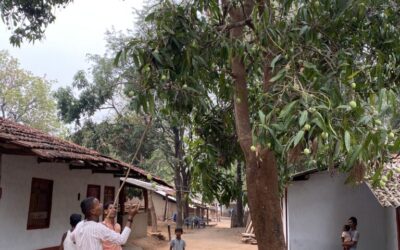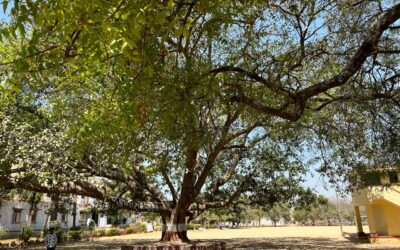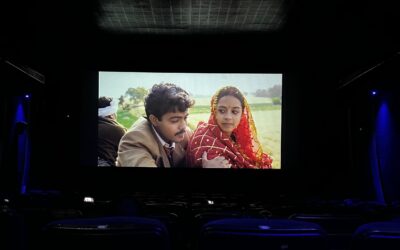The World Bank defines extreme poverty as living on less than $2.15 a day. In India, $2.15 is the national minimum wage and translates into Rs. 178 per day. Unfortunately, for many in my community in Dindori, Madhya Pradesh, the hourly wage is only Rs. 4 and most earn a total of Rs. 32 for a full day of hard labour. This form of low-paying, daily wage earners doing ‘rojghari‘ exacerbates rural poverty and deepens communities into a vicious poverty trap.

So What Happens During an Emergency?
During a trip to a local village with Santoshi Markam, a team member, we found a small lassi shop. After paying for her glass of lassi, she casually told me that she had 1 rupee remaining in her account. She then giggled and continued on her way. Immediately appalled, I offered that she could borrow money from me if she needed it. She, however, seemed perfectly relaxed about her bank balance despite her next pay check arriving a week later. Curious to know more, I asked her what happens during an emergency.
Santoshi’s family also has no savings despite her and her husband having a stable, monthly income, she said. She spends most of her money the minute she receives her salary to pay bills including rent for her house and her dad’s tailor shop, 1.5 litres of milk a day for her young child and paying off any loans she has taken from friends and family. In emergencies, her family would mortgage their house, sell plots of land they own in her village or sell their gold jewellery. This has happened on multiple occasions and they have sold a motorbike, jewels and pieces of land in their village.
Overhearing this conversation, others in my team also joined in to explain what their financial situation looked like. When I casually surveyed others on my team, I realised that most of them were living pay check to pay check. They were barely able to save for emergencies and had no reliable contingency plan if their financial situation deteriorated. Their condition was significantly worse when their families were larger or they had only one earning member.
Access to Conventional Banking
Loans were not an option for anyone on my team. Banks only provide loans to government employees in Dindori, and none of my team members were in government jobs. According to the Indian Constitution, Article 311 states that government employees cannot be dismissed and are protected from arbitrary removal from their positions of service. This bill provides government employees with guaranteed job security. This job security makes them reliable persons for successful loan recovery as compared to employees in private or non-governmental organisations making only a living wage.
Santoshi also told me of instances where she tried to take a small loan to buy a motorbike or pay for hospital bills; all applications were rejected despite having a stable job in a reputed non-profit with several years of income depicted on her bank statements.
Self-Help Groups (SHGs)
Also read: Collectives: Empowering Individuals for Social Change
My colleagues then told me that many poor rural women join self-help groups called ‘Samuh‘ to get microfinance loans. In India, the Mahila Samriddhi Yojana was established in 1993 where micro-financing loans of up to 1.25 lakhs will be provided at 6% interest per annum. In Madhya Pradesh, based on my interviews, a group of ten women start with 10,000 rupees each. Their yearly interest is broken down into weekly instalments of Rs. 50 making it easier to pay back. If all ten women successfully pay back their interest within the year, the principal value they can borrow increases.
This way, women build up a reliable credit score and the group acts as collateral instead of properties. In many such communities around the Dindori district, men send their wives to join self-help groups to get capital to start a business or a shop. Samuh Bank and Bandhan Bank offer these services across many villages in Dindori.
High-Interest Loans and Rural Poverty
Santoshi also told me that you can get high-interest private loans from other villagers; this practice is called usury. Loans are provided at unreasonably high interest rates and act as a last resort for many poor families. Mortgages on houses, motor vehicles, or jewellery have an interest of 10 to 15% per month in Dindori. In 7 to 10 months, the interest value would match or exceed the principle; the borrower would then have to pay back twice the money they borrowed initially. For the poor, this is an impossible situation, also called a debt trap, where due to financial hardships, they deepen into poverty.
Another colleague, Narendra, gave me an instance where his uncle, who lives near Bilaspur, Chhattisgarh, borrowed Rs. 7,000 due to a bad harvest. He got this money for a 15% interest rate meaning that he had to pay back over Rs. 8,000 the following month. Unfortunately, he failed to do so and his interest kept accumulating. Now, a year later, he owes just over Rs. 20,000. Narendra explained how even if his uncle dies, his children inherit the loan until they are able to pay it off to completion. This cycle of worsening debt burden on the Indian poor creates an intergenerational vicious cycle of poverty where multiple generations are unable to overcome their financial condition and create sustainable livelihoods.
Stories From the 1985-87 Famine
Narendra and Santoshi progressed to chronicle how their families navigated the three-year famine and drought from 1985 to 1987. Santoshi’s dad’s family had to mortgage their properties and motor vehicles to a rich neighbour for a single month’s rations. Due to the severity of the drought, her dad and his parents mixed a little maize, or Makka, with a lot of water and drank this mixture for several meals. Many neighbours in their village who had no property, gold or motor vehicles to mortgage died of starvation.
Similarly, in Chattisgarh, many people survived the drought eating charota, a wild weed that most species do not consume. Due to large families with many children, parents would ask their children to forage; the children would eat poisonous fruits or babul which has thorns and die. Many also perished by drinking dirty water from ponds due to a lack of access to better resources or clean food. Data supports these claims that around 42 to 47% of India was in drought between 1985 and 1987.
Financial security extends to every area of our lives, irrespective of whether we are poor or rich, and is directly correlated with access to public infrastructure including food, water and healthcare. These resources are harder to acquire for those in rural parts of the country or those with fewer financial resources.
Together, lack of access to financial resources and public infrastructure during a crisis, makes it harder for people to overcome the persistent cycle of poverty in rural communities. This creates the perfect storm – where those who are down to the last rupee will always remain there in perpetuity.
*Names have been changed to maintain anonymity




0 Comments